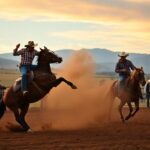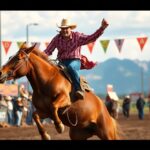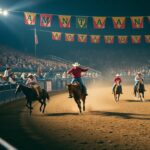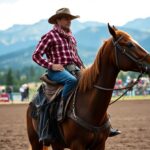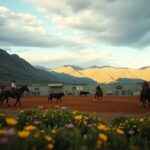What Rare Skills Must Athletes Cultivate To Excel In Montana Rodeos?
Just as you prepare for competition, understanding the unique and demanding skills needed for Montana rodeos is necessary. The exhilarating sport combines physical prowess with mental toughness, requiring you to master disciplines such as bull riding, barrel racing, and team roping. Beyond raw strength, your ability to read animal behavior, react quickly under pressure, and maintain unwavering focus can be the difference between victory and injury. Dive into the world of Montana rodeos to discover the rare skills that can elevate your performance and ensure your safety in this thrilling arena.

Core Physical Skills
Strength and Endurance
Strength is a fundamental component of success in Montana rodeos. Your ability to lift, pull, and resist forces is paramount whether you’re mounting a bucking bronco or holding onto a rope during a calf scramble. Developing your upper body strength will allow you to gain effective control over your equipment and handle your mount with the necessary authority. Furthermore, a robust core will improve your overall stability and balance, imperative qualities for the unpredictable nature of rodeo events. Endurance complements strength; rodeo competitions can be physically taxing, requiring you to stay alert and vigorous over extended periods. Regular training, including rowing, swimming, and resistance exercises, can enhance your stamina and ensure you remain strong throughout the event.
Agility and Coordination
After establishing a solid foundation of strength and endurance, the next step is to focus on agility and coordination. Agility allows you to react swiftly to sudden changes, such as a horse’s movement or a steer breaking from the herd. The ability to shift your body weight quickly while maintaining balance is crucial to executing maneuvers smoothly and effectively. Training methods like ladder drills, cone exercises, and balancing techniques can significantly boost your ability to perform under pressure.
The benefits of agility and coordination in rodeos extend beyond mere physical capability; they directly impact your safety and success. Neglecting these skills could lead to serious injuries, particularly when faced with unpredictable animal behavior. Being agile allows you to avoid potential hazards and react intelligently during competitions. Your coordination ties all movements together, ensuring that your actions are fluid, controlled, and purposeful. By prioritizing agility and coordination in your training, you position yourself to compete effectively and safely in Montana rodeos.
Mental Resilience
Now, mental resilience is one of the key traits that can set successful rodeo athletes apart from the competition in Montana. This quality allows you to navigate the ups and downs of the rodeo circuit, including the inevitable setbacks and challenges you will face. Cultivating mental toughness means developing the ability to stay focused under pressure, harnessing your emotions, and maintaining a strong competitive spirit through every event. By building this resilience, you will find that your performance not only improves but that you also enjoy the rodeo experience more deeply.
Focus and Concentration
Below are techniques to enhance your focus and concentration, which is necessary for performing at your best during rides and roping events. Eliminating distractions is paramount; setting aside time for mental practice can help you visualize rides effectively and prepare for unexpected outcomes. Additionally, practicing mindfulness can strengthen your ability to stay present, enabling rapid decision-making during high-pressure situations. By honing these skills, you’ll be equipped to rise above the noise and chaos that comes with rodeo competitions.
Stress Management Techniques
Stress is an unavoidable factor in any competitive environment, and rodeos are no exception. Knowing how to manage stress effectively can not only improve your performance but also protect your overall well-being. Techniques such as breathing exercises, progressive muscle relaxation, and visualization can be highly beneficial for maintaining your composure. Integrating these into your routine allows you to take control of anxiety and convert it into competitive energy.
In fact, mastering stress management techniques can significantly enhance your mental game. Techniques like deep breathing and meditation can lower your heart rate and promote a feeling of calm, while positive self-talk can help you override doubts and fears. By developing a personal toolkit for managing stress, you can ensure that you remain focused and composed, allowing your skills to shine when it counts the most.
Technical Rodeo Proficiencies
Any aspiring rodeo athlete in Montana must develop an array of technical proficiencies to stand out in the competitive landscape of rodeo events. These skills not only heighten your performance but also ensure your safety while navigating the challenging and thrilling world of rodeo. Among the most vital of these proficiencies are roping skills and riding techniques, each demanding dedication and a strong work ethic to master. As you refine these skills, you will enhance your ability to compete effectively, build resilience, and forge deeper connections with your horse.
Roping Skills
Roping is an art form that extends beyond the basic mechanics of throwing a lasso; it involves timing, precision, and a keen understanding of animal behavior. When you practice your roping skills, focus on developing a smooth swing and an ability to read your target’s movements. Whether you are working to catch a steer in team roping or preparing for calf roping, your success depends on your hand-eye coordination and overall agility. Engaging in drills that enhance your target accuracy can lead to improved performance in competitions.
Riding Techniques
The foundation of your rodeo prowess lies in your riding techniques, as being proficient on horseback is important for most events you will encounter. To excel, you must master the balance between control and responsiveness while maintaining a strong connection with your horse. This involves not only gripping the reins with confidence but also using your body language and weight distribution to guide your horse effectively. Engaging regularly in practice rides can improve your timing and reactions, making you more adept in events like bull riding or bareback bronc riding, where quick, decisive moves are necessary to stay aboard.
It is important to practice in various conditions to enhance your adaptability, especially when you are facing sudden challenges during performances. Maintaining your composure under pressure is vital, as is establishing trust between you and your horse. Implement exercises focused on your horse’s responsiveness, such as maneuvers requiring quick turns or stops, to test and develop your strengths. Recall, each ride is an opportunity to refine your techniques further and prepare you for the unpredictable nature of rodeo competition.
Local Knowledge and Adaptability
Many athletes aspiring to compete in Montana rodeos quickly realize that local knowledge and the ability to adapt are imperative skills. Understanding the unique culture, traditions, and terrain of Montana will give you a significant edge in this competitive environment. By familiarizing yourself with the history and customs that surround rodeos in this region, you can also build strong relationships with fellow competitors and locals. This support network can be invaluable. For more insights, check out A Cheat Sheet to Rodeos – Visit Southeast Montana, which offers great tips for navigating the rodeo scene.
Understanding Regional Conditions
Above all, adapting to the specific environmental conditions in Montana—from the unpredictable weather to the diverse terrain—is vital for your safety and performance. As you prepare for events, take the time to scout the rodeo location. Being aware of variables like wind patterns and ground conditions can impact your success. Additionally, knowing how to handle the local wildlife and stay safe while riding in wide-open spaces is paramount. You want to ensure that you’re not just physically ready but mentally prepared for any challenges you might face.
Adapting to Different Rodeo Events
An athlete must be versatile when it comes to the variety of events in Montana rodeos. Each rodeo discipline—be it bronc riding, barrel racing, or team roping—presents different challenges and requires distinct skills. You’ll need to tailor your training and strategies to effectively meet these diverse demands. Understanding the specific requirements and techniques for each event will elevate your chances of excelling, as well as enhance your overall rodeo experience.
Plus, as you participate in various events, you’ll find that flexibility in your skill set will help you thrive. For instance, mastering the art of quick transitions between events can significantly boost your performance on the day of the rodeo. Additionally, recognizing how your body reacts to each style of riding will enable you to adjust your techniques and training regimens accordingly. As with any sport, prioritizing safety and proper preparation will be paramount to ensure you’re performing at your best while minimizing the risks involved.
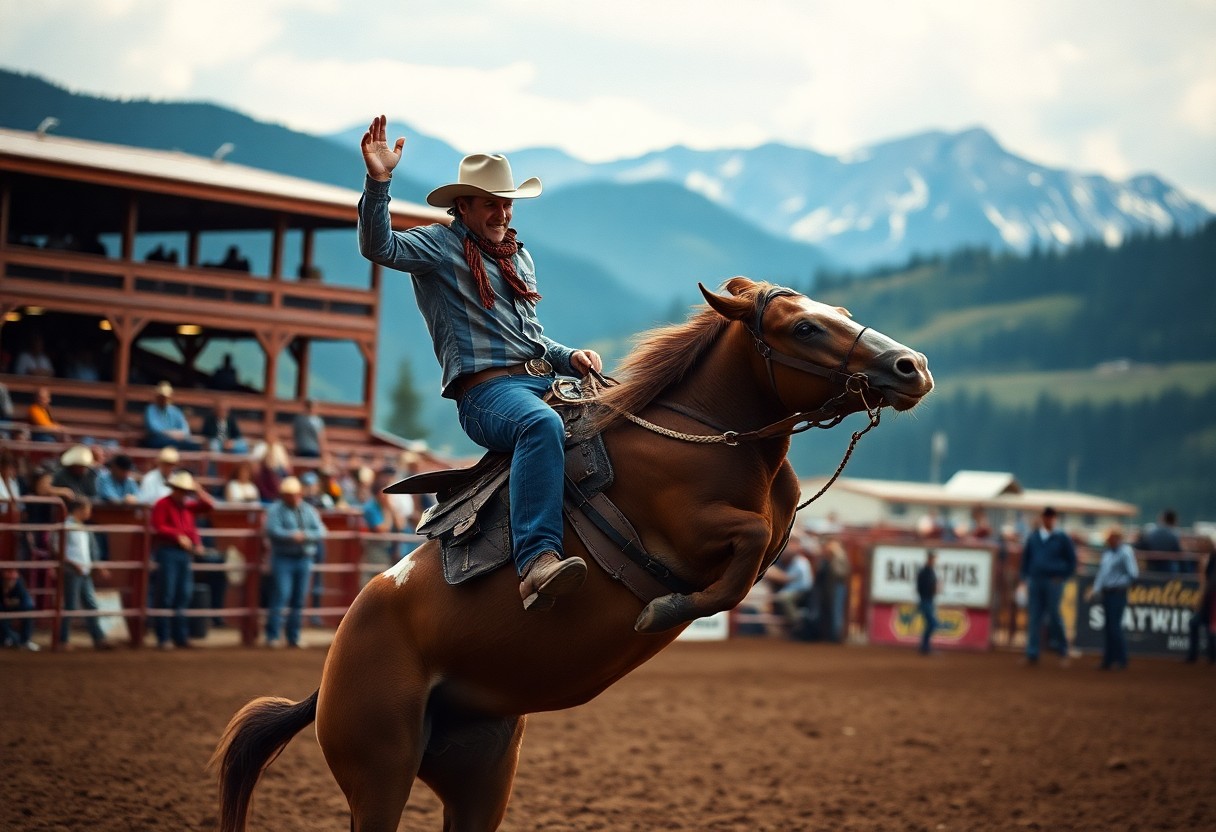
Teamwork and Communication
For any athlete participating in Montana rodeos, the ability to work well with others is important. Rodeos are not just an individual sport; they are a collective effort that relies on effective communication and collaboration among team members, crews, and even fellow competitors. You must be able to convey your intentions clearly and understand the signals and cues from your teammates as you prepare for competitions. Teamwork is vital not only for performance during the event but also for safety, as working together can help prevent accidents and injuries that may occur in high-stakes situations.
Collaborating with Crews
With a successful rodeo event heavily relying on the efforts of your crew, it’s important to foster an environment of open dialogue and shared objectives. Your crew members often handle everything from setting up the arena to caring for the animals involved, and their expertise can significantly enhance your performance. You need to ensure that everyone is on the same page and that duties are clearly defined, so nothing falls through the cracks. Establishing a routine for communication before and during events can streamline processes and create a more cohesive unit that operates like a well-oiled machine.
Building Relationships with Competitors
At rodeos, you are often competing against athletes who can become allies rather than mere rivals. Building relationships with your competitors can provide you with unique insights and foster a sense of camaraderie that enriches the competitive experience. These interactions can open the door to valuable advice, tips on performance techniques, and even collaboration in informal practice settings. It’s important to maintain a level of respect and sportsmanship that can encourage bonding rather than hostility, which ultimately elevates the entire rodeo culture.
Relationships with competitors can also turn out to be a double-edged sword. While nurturing friendly connections can lead to a supportive environment, it’s important to recognize the fine line between camaraderie and rivalry. When you challenge one another, it often motivates you to push your limits, but it’s vital to balance this with a spirit of respect and encouragement. Whether celebrating victories or reflecting on defeats, these relationships contribute to a positive atmosphere that can significantly enhance your rodeo experience and performance.
Continuous Learning and Improvement
Once again, the landscape of Montana rodeos demands that you commit to a path of continuous learning and improvement. The world of rodeo is ever-evolving, and to stay competitive, you must actively seek out opportunities to refine your skills. This entails not only perfecting your technique in various events but also understanding the intricacies of animal behavior, equipment advancements, and safety practices. By embracing a philosophy of lifelong learning, you set yourself up for sustained success in this challenging arena.
Seeking Coaching and Feedback
Behind every successful rodeo athlete lies a foundation of mentorship and constructive criticism. You should seek out experienced coaches who can observe your performance and provide insightful feedback. Engaging with mentors who have seen the highs and lows of the rodeo world will not only elevate your technique but also offer you a wealth of knowledge about the sport. Consistent check-ins with your coach can help you identify specific areas for improvement, ensuring that you are always progressing towards your goals.
Staying Current with Trends and Innovations
One of the most significant aspects of excelling in the rodeo scene is your ability to stay informed about trends and innovations that can enhance your performance. This includes understanding the latest safety gear, training methods, and techniques that others are adopting. By keeping an eye on industry advancements and investing time in research, you position yourself to gain a competitive edge. Your willingness to adapt to new practices can also enhance the overall safety and effectiveness of your routines, ultimately protecting both you and your animal partners.
Due to the fast-paced nature of the rodeo circuit, remaining adaptable can mean the difference between success and setbacks. Innovations in technology, such as performance-tracking apps and improved rodeo gear, are continually emerging. By integrating these advancements into your training regimen, you can optimize your performance while ensuring you’re operating at the highest standards. Staying connected with fellow competitors and participating in workshops or clinics will also keep you at the forefront of this dynamic sport, reinforcing the importance of being a proactive learner.
Final Words
From above, it is clear that excelling in Montana rodeos demands a unique set of skills that go beyond mere physical strength. You must focus on cultivating a deep understanding of the animals you work with, which includes their behavior and nuances. This knowledge can give you an edge, allowing you to connect with the animal and anticipate its movements as you compete. Additionally, honing your mental fortitude is just as important; developing focus, resilience, and adaptability will enable you to perform at your best even under pressure. The ability to remain calm and make quick decisions during intense moments can often make the difference in the arena.
Furthermore, honing your strategic skills is important in this competitive sport. Analyzing your performances and learning from each ride will help you identify areas for improvement and adjust your techniques accordingly. You should also embrace the importance of teamwork and mentorship, as building relationships with fellow competitors and seasoned professionals can provide invaluable insights. All these elements combined will help you navigate the dynamic environment of Montana rodeos, ensuring that you not only participate but truly excel in this rich and challenging tradition.
Q: What specific mental skills are important for athletes to succeed in Montana rodeos?
A: Mental skills are vital for rodeo athletes, especially in high-pressure situations. Focus is crucial, as competitors must pay attention to their surroundings, including the behavior of both their horses and the animals they are competing against. Another important mental skill is resilience; athletes must be able to bounce back from setbacks, whether it’s a missed rodeo or a disappointing performance. Lastly, visualization techniques can greatly enhance an athlete’s ability to perform under pressure. By mentally rehearsing their routines and envisioning success, they can build confidence and reduce anxiety during actual events.
Q: How important is physical conditioning for rodeo athletes in Montana, and what should it include?
A: Physical conditioning is extremely important for rodeo athletes, as it directly impacts their performance. Training should focus on building core strength, agility, and endurance, as these attributes are crucial for controlling horses and maintaining balance during events. Engaging in activities such as strength training, cardiovascular exercises, and flexibility workouts can help athletes improve their physical capabilities. Additionally, sport-specific training, including practice on roping and riding skills, will enhance their overall performance by preparing their bodies for the unique demands of rodeo events.
Q: What role do community relationships play in the success of athletes participating in Montana rodeos?
A: Building strong relationships within the rodeo community can significantly impact an athlete’s success. Networking with experienced rodeo participants offers valuable insights, tips, and mentorship opportunities that can help newer athletes improve their skills. Engaging with local trainers, participating in workshops, and attending rodeo events can also create a sense of belonging and support. Additionally, a positive relationship with sponsors and local businesses can provide financial assistance and resources, helping athletes access better training facilities or equipment needed for competitions.
![]()

